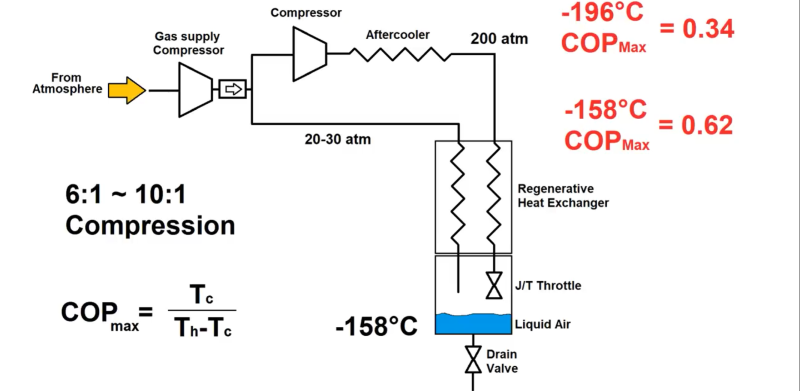The fun part about crycoolers is that there are so many different and exciting ways to make stuff cold, based on a wide variety of physics. This is why after first exploring the Stirling/GM cycle and vapor-compression to create a cryocooler that he could liquefy nitrogen with, [Hyperspace Pirate] is exploring a Joule-Thomson cooler, which is also misspelled as ‘Joule-Thompson’ by those who don’t mind take some liberties with history. Either way, the advantage of the adiabatic Joule-Thomson effect is that it is significantly simpler than the other methods — having been invented in the 19th century and used for the earliest forms of refrigeration.

The big difference between it and other technologies is that the effect is based on throttling the flow of a gas as it seeks to expand, within specific temperature and pressure ranges to ensure that the temperature change effect is positive (i.e. the temperature of the gas decreases). The net result is that of a cooling effect, which as demonstrated in the video can be used with successive stages involving different gases, or a gas mixture, to reach a low enough temperature at which nitrogen (contained in the same gas mixture) liquefies and can be collected.
Although not a very efficient process, if your local electricity costs allow it, running the compressor in a closed loop version isn’t that expensive and worth it for the science alone. Naturally, as with any experimental setup involving a range of gases, a compressor and other components, getting it to run perfectly on the first try is basically impossible, which is why this is so far Part 1 of another series on cryocoolers at home (or in the garage).
If you’re interested in the previous work [Hyperspace Pirate] has done with DIY cyrocoolers, take a look at our coverage from earlier this year.

















Corrections:
“create a cryocooler that could liquefy nitrogen with” -> “create a cryocooler with which to liquefy nitrogen”, or if you want to continue to have an informal tone, “create a cryocooler to liquefy nitrogen with”. Otherwise, you’d need a pronoun in between “that” and “could”.
“by those who don’t mind take some liberties with history” -> “by those who don’t mind taking some liberties with history”
And after school restarts in Fall you’ll be busy correcting student homework.
But in the meantime, Hackaday blogs will keep your skills sharp!
Watching this series with great hopes. If this ends up with a cost effective way to make liquid air with salvaged air conditioner parts, I’ll be all in on a new project.
One of the trickiest parts to liquifying at least some of the components of air is simply getting a clean and most importantly dry air source.
There really needs to be a way to support people in WRITING UP these projects. Video is more work for the producer, slower to consume, harder to refer to, usually less detailed, and just a generally inferior way of documenting anything.
While all of these are true, for the same content, putting a video on youtube will get 100x the views of putting a writeup on twitter, and 1000x the views of putting a writeup on a blog. I have a half million views on one of my youtube videos, and got zero comments on the text-and-pictures-on-a-blog writeup of the same material. So if your intent is for your information to reach the largest number of people, you choose youtube. Sucks, but that’s the way algorithmic popularity works.
Visual creatures, what did people expect?
Speak for yourself. I prefer video by far, and it seems like at least a portion of the 75,000 people who watched this video in the 3 days it has been out agree.
In this case, he can speak for me, too.
“Just watch this video” means, in my personal lexicon, “approach learning about this topic differently, and, if someone you know sent an unsolicited video, mute that conversation for a least a day”
It may not work for the algorithm, but I would certainly be willing to contribute actual money to avoid having to slog through a video about an eclectic topic.
Do the embedded video’s “watch on youtube” links not work for everyone, or just me? I get a blocked message, but can search on youtube then watch the video just fine.
It’s not just you, we’ve been getting reports from others as well. Looking into it.